September 2009
Armed Virginia Sloop - Odds and Ends
27 - September - 2009 - 20:43
I was off on vacation for a week, so the updates lagged a bit behind. But, now I am back and have had a little time to work on the ship.
I don't really have any great insights to share this time around, so just a quick post to update my progress and show a few photos of where I am at the moment.
First off, I had to wrap up a few remaining deck fixtures. This included the little stairs to the top deck/roof, lots of little cleats, attaching all the bases for the swivel cannons, the swivel cannons themselves, various holes being drilled for future attachments, etc. Also, I added the channels, chainplates and deadeyes (those wings and round things sticking off the sides of the ship) in preparation for adding the masts and rigging.
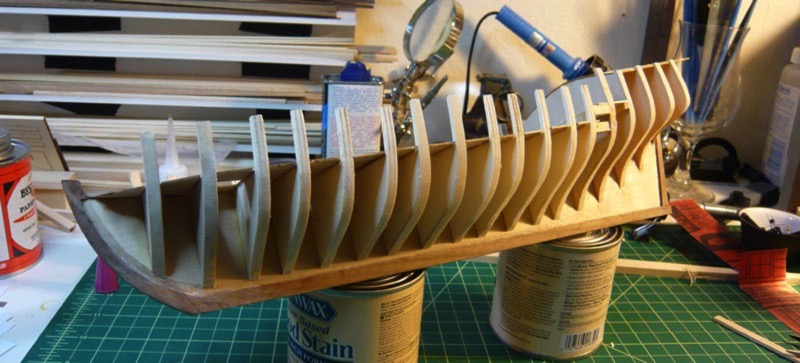
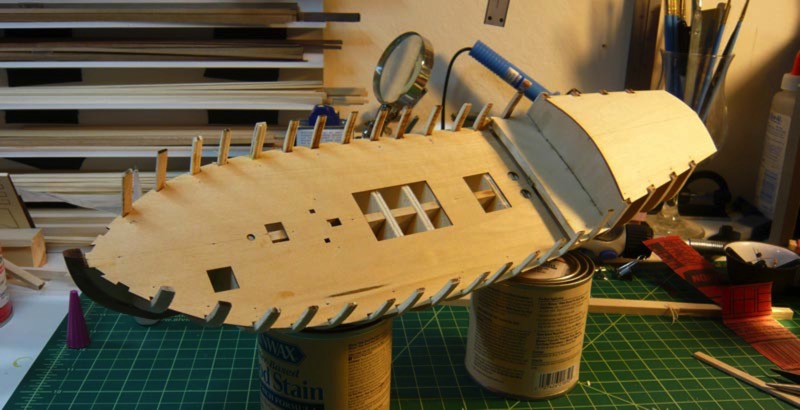
Next, since the ship is mostly just getting rigging stuff added from this point on, I built the real base, which is a model of the launching ways. This was built all from 1/4" basswood stock, cut to size, stained, and then glued into place. There was a little bit of fiddly work, getting all the proper angles cut into the upright support parts, but nothing too tough :)
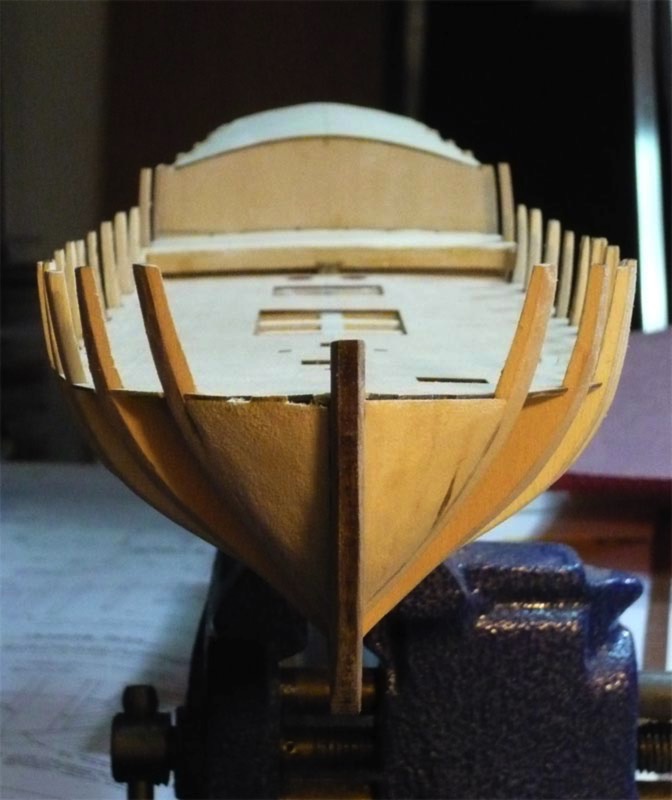
Finally, I've started work on the masts. First up was the bowsprit (big one) and the jibboom (little one). The bowsprit was fashioned from a 3/8" dowel which has to be slimmed down by using a combination of sanding drums in a dremel, and sanding the dowel while it is spinning in a drill. This was mostly quite a bit of experimentation, and I can't say that either method really worked all that well, but it got the job done. Anyhow, that's where I am now, with the bowsprit temporarily installed. Next up are various little fittings on the bowsprit, and then moving on to the main mast.
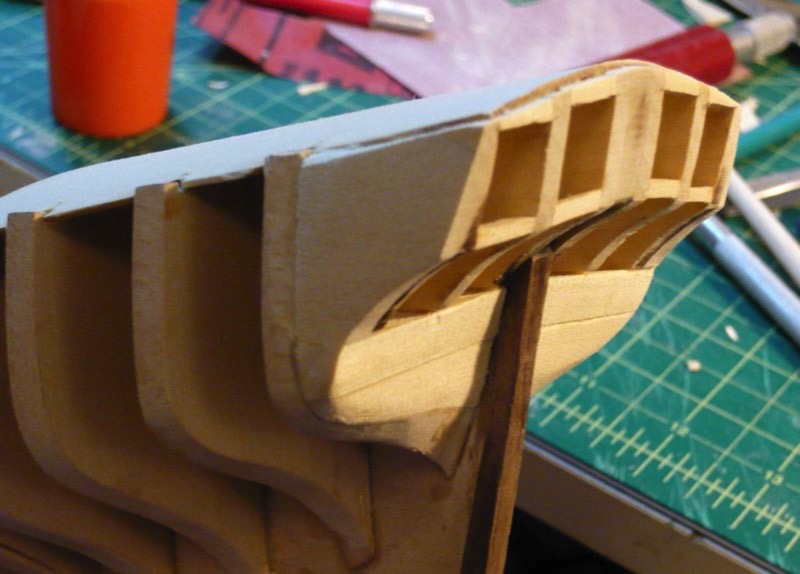
I don't really have any great insights to share this time around, so just a quick post to update my progress and show a few photos of where I am at the moment.
First off, I had to wrap up a few remaining deck fixtures. This included the little stairs to the top deck/roof, lots of little cleats, attaching all the bases for the swivel cannons, the swivel cannons themselves, various holes being drilled for future attachments, etc. Also, I added the channels, chainplates and deadeyes (those wings and round things sticking off the sides of the ship) in preparation for adding the masts and rigging.


Next, since the ship is mostly just getting rigging stuff added from this point on, I built the real base, which is a model of the launching ways. This was built all from 1/4" basswood stock, cut to size, stained, and then glued into place. There was a little bit of fiddly work, getting all the proper angles cut into the upright support parts, but nothing too tough :)

Finally, I've started work on the masts. First up was the bowsprit (big one) and the jibboom (little one). The bowsprit was fashioned from a 3/8" dowel which has to be slimmed down by using a combination of sanding drums in a dremel, and sanding the dowel while it is spinning in a drill. This was mostly quite a bit of experimentation, and I can't say that either method really worked all that well, but it got the job done. Anyhow, that's where I am now, with the bowsprit temporarily installed. Next up are various little fittings on the bowsprit, and then moving on to the main mast.

Armed Virginia Sloop - Getting Crowded On Deck
07 - September - 2009 - 22:00
Another small update today. This mostly consists of various deck furniture and fittings. First up are the boom crutches:

(very exciting, I know)
In the next photo, you can see the smokestack for the galley, the riding bitt (little rope rack thing in the left-middle, there) and the catheads (little arms that stick off the front. No cats harmed in the making of this model).
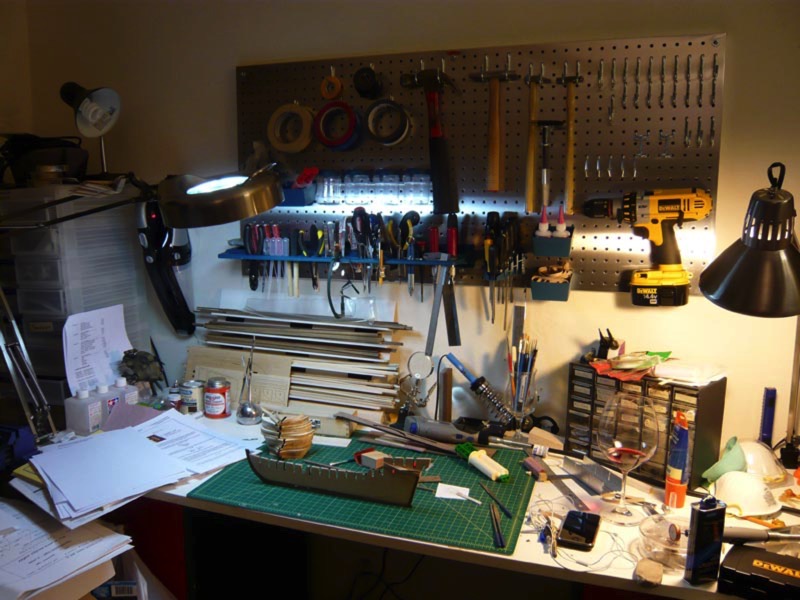
Then, the more complicated stuff: The ships wheel, the water pumps and the binnacle. The ships wheel and pumps seems fairly self evident, but if you are like me, you probably thought something like, "Binnacle? Is that like a barnacle? Perhaps the pinnacle of all barnacles, a sort of super-barnacle?" Turns out a binnacle is that little cabinet thing in front of the ships wheel that houses, among other things, the ships compass, which is supposed to be behind the little window.
The only noteworthy thing here is that I tried out using my drill as a makeshift lathe in order to turn a dowel into a pulley for the ships wheel (left side, where the string loops around). It seems to have worked decently, but I wouldn't recommend it for precision work.
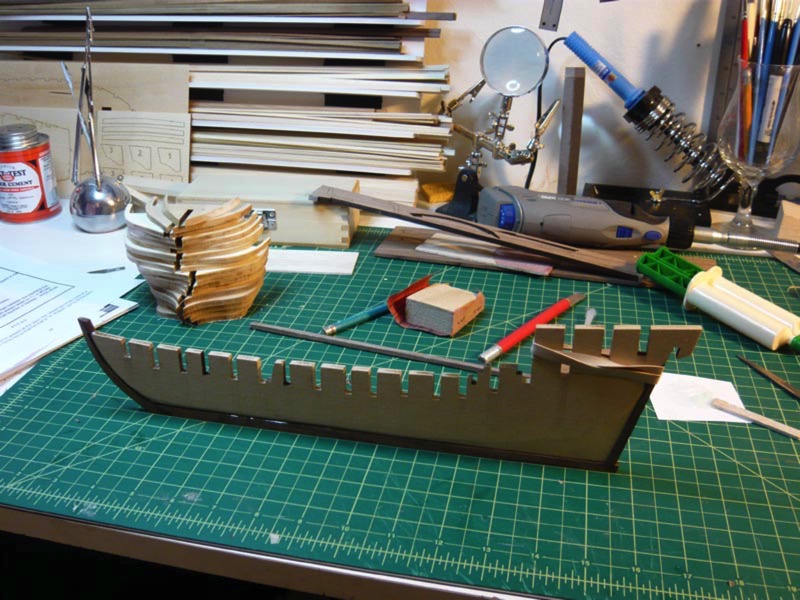
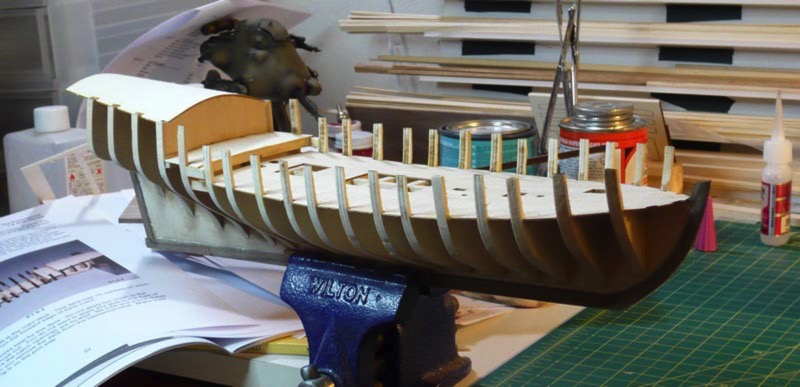
That's where I am now. More updates to follow as I progress!

(very exciting, I know)
In the next photo, you can see the smokestack for the galley, the riding bitt (little rope rack thing in the left-middle, there) and the catheads (little arms that stick off the front. No cats harmed in the making of this model).

Then, the more complicated stuff: The ships wheel, the water pumps and the binnacle. The ships wheel and pumps seems fairly self evident, but if you are like me, you probably thought something like, "Binnacle? Is that like a barnacle? Perhaps the pinnacle of all barnacles, a sort of super-barnacle?" Turns out a binnacle is that little cabinet thing in front of the ships wheel that houses, among other things, the ships compass, which is supposed to be behind the little window.
The only noteworthy thing here is that I tried out using my drill as a makeshift lathe in order to turn a dowel into a pulley for the ships wheel (left side, where the string loops around). It seems to have worked decently, but I wouldn't recommend it for precision work.


That's where I am now. More updates to follow as I progress!
Armed Virginia Sloop - Now Armed!
02 - September - 2009 - 21:48
First off, I've gotten the rudder attached. This wasn't too tough, but I thought that I would share a little trick I used. The course I am following didn't make any mention of the little bolt heads that secure the straps to the rudder and to the ship. The plans make a brief mention of using cut off bits of wire for these bolt heads. I figured that even if I managed to cut off that small of a piece of wire without it flying across the room and disappearing, then trying to get that tiny bit super glued to the rudder was going to be practically impossible. So, instead, I borrowed a jar of acrylic medium (thick), and dipped a T pin into it and dabbed little bits of the gel onto the metal straps. This left nice little dots on there, which were just the right size. Once dry, a little brush with fine sandpaper to take the points off the dabs, and then I painted over both the metal strap and the gel and it all turned out pretty well, if I may say so.
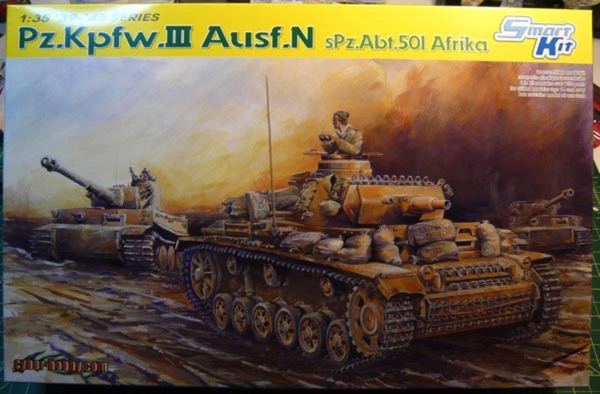
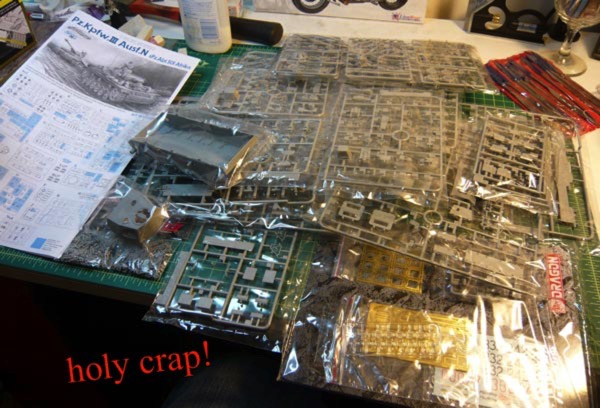
Once the rudder was all done, I set about rigging, and attaching the cannons to the ship. The rigging was extra fiddly, as it required some very small knots be tied and some fairly springy rope be coiled. I am now proud to say that I can precisely tie an hangman's knot that is only a few millimeters long. Should anyone need to hang any traitorous insects, I can be of assistance.
This step had one goof and one trick.
The goof: turns out I rigged the cannons backwards when it came to the little block-and-tackle things on the sides. The blocks with two holes were supposed to be towards the outside of the ship, resulting in the rope exiting the rigging near the railing of the ship and making much more sense, if you think about how one would haul on the rope to run the cannon out. But since I didn't discover this until I had already rigged all the cannons, I decided it wasn't too big a deal.
The trick: The course I am following suggested forming the rope coils (on the deck next to each cannon) by soaking the string in a mixture of Elmer's glue and water and then then using a wet paintbrush to form the ring of rope. I think my string may have been a different type (polyester instead of cotton), since it didn't really seem to soak up the glue mixture and become more pliable. Instead it mostly just spread glue all around the deck of the ship as I tried to get it to stay in place. Eventually, I gave up on that method and decided to instead form the coils by wrapping the string around the handle of a paintbrush (carefully overlapping, so that it built up some thickness and held itself in place) and the putting a dab of superglue (fast) on at the end to hold the coil together. Then, before the glue complete hardened, I slipped the coil off the brush handle and glued it down to the deck with another dab of superglue (slow). This seemed to do the trick, and aside from gluing my fingers together and to the rope a few times, it turned out pretty well.
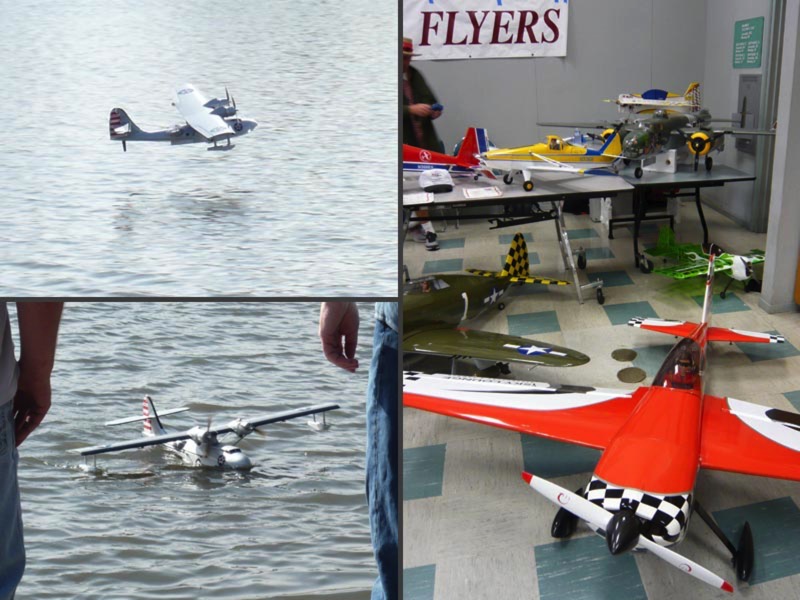
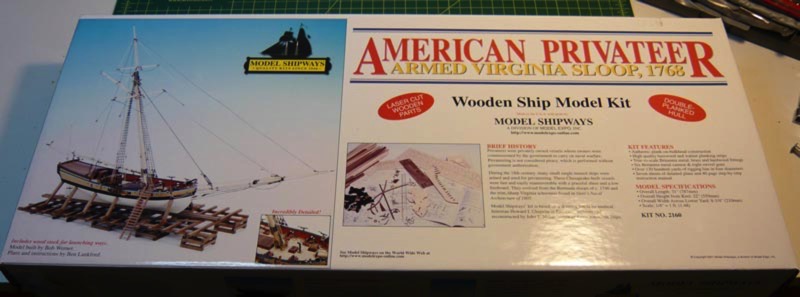
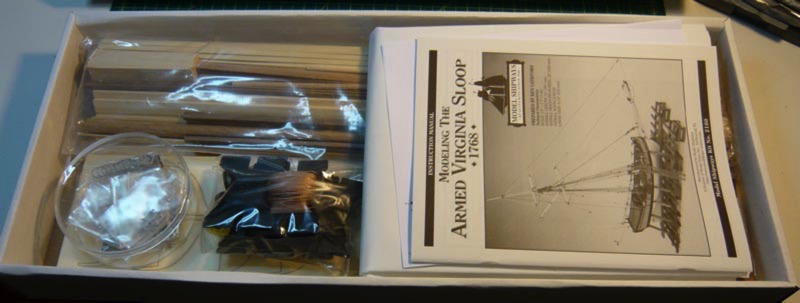
That's it for now. Next up are a few more pieces of random deck furniture, the little railing guns and various rigging fittings.


Once the rudder was all done, I set about rigging, and attaching the cannons to the ship. The rigging was extra fiddly, as it required some very small knots be tied and some fairly springy rope be coiled. I am now proud to say that I can precisely tie an hangman's knot that is only a few millimeters long. Should anyone need to hang any traitorous insects, I can be of assistance.
This step had one goof and one trick.
The goof: turns out I rigged the cannons backwards when it came to the little block-and-tackle things on the sides. The blocks with two holes were supposed to be towards the outside of the ship, resulting in the rope exiting the rigging near the railing of the ship and making much more sense, if you think about how one would haul on the rope to run the cannon out. But since I didn't discover this until I had already rigged all the cannons, I decided it wasn't too big a deal.
The trick: The course I am following suggested forming the rope coils (on the deck next to each cannon) by soaking the string in a mixture of Elmer's glue and water and then then using a wet paintbrush to form the ring of rope. I think my string may have been a different type (polyester instead of cotton), since it didn't really seem to soak up the glue mixture and become more pliable. Instead it mostly just spread glue all around the deck of the ship as I tried to get it to stay in place. Eventually, I gave up on that method and decided to instead form the coils by wrapping the string around the handle of a paintbrush (carefully overlapping, so that it built up some thickness and held itself in place) and the putting a dab of superglue (fast) on at the end to hold the coil together. Then, before the glue complete hardened, I slipped the coil off the brush handle and glued it down to the deck with another dab of superglue (slow). This seemed to do the trick, and aside from gluing my fingers together and to the rope a few times, it turned out pretty well.



That's it for now. Next up are a few more pieces of random deck furniture, the little railing guns and various rigging fittings.
